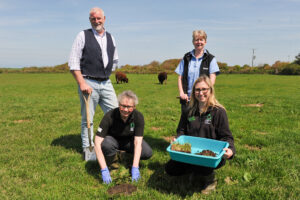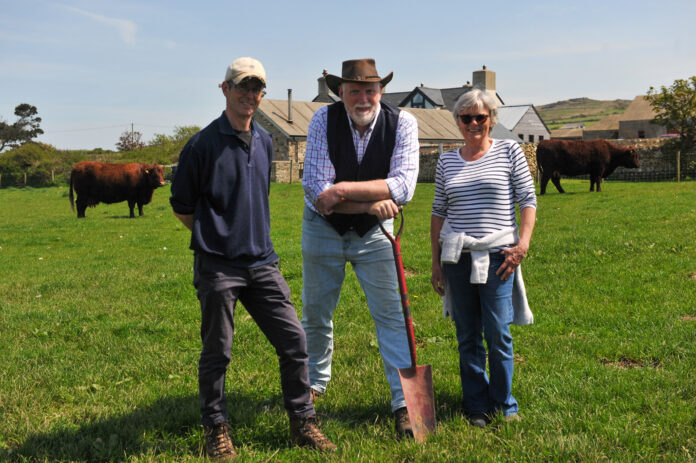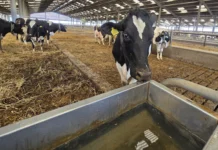Reducing soil disturbance, growing cover crops and increasing plant diversity will help Welsh farms better cope with future climate challenges.
As the industry moves towards utilising more sustainable food production techniques, the goal of every farm should be to increase soil organic carbon, insists Neil Fuller, an expert in the science of soil management.
At a recent Farming Connect soil health event at Treathro Farm, a beef farm near Strumble Head, Pembrokeshire, where David and Debbie Best are trialling different soil management practices, Mr Fuller said soil health offered significant sustainability and productivity outcomes for farm businesses.
As a starting point, he recommended getting an active measurement of the health of farm soils – its biological, physical and chemical health.
From microscopic fungi and bacteria to earthworms and beetles, soil contains billions of organisms.
“Most are beneficial to crops and perform a variety of functions, from breaking down organic matter and improving soil structure and drainage,’’ said Mr Fuller.
Many will also act as predators for pests, reducing the need for chemicals.

Earthworms are good indicators of soil health as they are sensitive to pH, waterlogging, compaction, rotations, tillage and organic matter.
Their numbers and distribution across a field can reveal what is going on under the surface.
Mr Fuller brought this message to life with a ‘soil safari’ by examining different soils and worm activity under a high-powered microscope and shared on a big screen.
Farm soils should have three types of earthworms – surface, topsoil and deep-burrowing earthworms.
Small surface worms live and feed on surface litter and organic amendments, topsoil earthworms are found in the topsoil, forming horizontal burrows that mix the soil and mobilise nutrients, and deep-burrowing earthworms make deep, vertical burrows.
While most soils have topsoil worms, the absence of surface and deep-burrowing worms suggest that the soil has been overworked and soil functioning is compromised.
Mr Fuller said the physical structure of the soil also needs to be considered.
If soil is compacted, there is less room for plant roots to grow and for air and water to circulate.
Compacted soils have lower infiltration and drainage rates, as well as reduced biological activity, plant root growth and yields.
They are also less able to cope with weather extremes, warned Mr Fuller.
Chemical properties are also important to soil health. Maintaining the optimum pH level and adequate supply of plant nutrients helps to support crop growth.
At Treathro, the Bests are working with Farming Connect to examine the impact of different management techniques and sward types on soil microbiology.
There are four trial fields: in one the Bests are rotational grazing their Red Devon suckler herd on permanent pasture and in another they intend to grow a minimum tillage herbal ley.
The other two trial sites are a field of perennial ryegrass and white clover used for haylage and a cliff-top field that is an SSSI and only lightly grazed by ponies.
Non Williams, Farming Connect Carbon Specialist Officer, said the average soil carbon stock in the top 10cm of soil was founds to be highest in the cliff top field, at 62.2 tonnes a hectare (t/ha), while in the rotationally grazed permanent pasture it was 51t/hectare (ha).
In the field used for haylage, it was 45.7t/ha and 41.7t/ha in remaining field.
Dr Williams said that at greater soil depth, 30-50cm below ground, the average soil carbon stock was highest – 30.4t/ha – in the perennial ryegrass and clover field used for haylage.
The project is also examining the levels of beneficial bacteria, fungi, protozoa and nematodes in the soil at Treathro.
Lynfa Davies, Farming Connect Biodiversity Specialist Officer, said this had shown that there were very dominant levels of beneficial bacteria.
Ideally fungi levels should be higher but she suggested low levels were typical of many agricultural soils.
“This can be improved through regenerative practices such as using deep-rooted leys using min-till methods which allow fungi to proliferate,’’ said Ms Davies.
Using less artificial fertilisers and increasing soil carbon will also help, she added.
But she warned that improving soil health is not a rapid process.
“It is important to remember that building soil health takes time and it may take several years before significant changes are seen,’’ said Ms Davies.
PANEL
Although farms like Treathro are planting species-rich swards, huge losses in quality diverse grassland during the last century mean that it now covers just 1% of land in the UK.
Sheena Duller, of Plantlife Cymru, a speaker at the Farming Connect event, said the organisation was working to restore it.
She explained that Plantlife helps farmers, landowners and community groups take care of grasslands by offering free practical advice.
By lobbying for policies and funding, one of its aims is to help create and restore species-rich grasslands.
“We want to partner with farmers and landowners who are eager to explore what diverse grasslands could do for them, their farms and for nature,’’ said Ms Duller.
“We can provide advice, technical support and information, which may help decisions around the Sustainable Farming Scheme and individual farm businesses.’’

| [donate]
| Help keep news FREE for our readersSupporting your local community newspaper/online news outlet is crucial now more than ever. If you believe in independent journalism,then consider making a valuable contribution by making a one-time or monthly donation. We operate in rural areas where providing unbiased news can be challenging. |




















Gardens too,most garden waste can be thrown onto borders as mulch saving alot of energy and feeding the soil